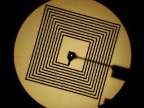GE Scientists Developing Wearable RFID Sensors to Detect Airborne Chemical Agents

GE Global Research, the technology development arm for the General Electric, today announced a $2 million award from the National Institute of Environmental Health Sciences to develop wearable RFID sensors to alert people to the presence of environmental chemical agents in the air and sample exhaled breath to serve as an early indicator of disease.
RFID sensors are commonly used to track a wide variety of items, from products in a supply chain to baggage at an airport. GE’s sensors are unique in that they combine RFID tracking with an acute gas sensing capability, which can detect the presence of potentially harmful chemical agents in the air. Because these sensors can be made at a size smaller than a penny, they can be part of a typical identification badge and serve as a pre-emptive or early warning for people about the presence of chemical agents in the air. Detecting chemical agents in this way could provide much more information about the relationship between a person’s health and the environment in which a person lives.
Radislav Potyrailo, a principal scientist at GE Global Research who is leading the wearable RFID sensor project, said, “We are creating a dynamic sensing platform that will provide real-time information to people about the presence of potentially harmful chemical agents in the air.”
Potyrailo added, “GE’s sensing platform could be readily adapted to many other interesting applications. For example, it could be used to analyze a person’s breath. Simply breathing on the sensor could potentially pick up biomarkers that serve as an early signal to the presence of certain diseases such as diabetes or cancer and metabolic disorders.“
“NIEHS is pleased to support this type of research,” said David Balshaw, Ph.D., a program administrator at the NIEHS. “In recent years, NIEHS has placed an emphasis on using innovative technologies like these sensors to better monitor individual exposures and understand how environmental exposures affect disease risk.” NIEHS provided the funding through the American Recovery and Reinvestment Act of 2009.
Breath analysis is an area being extensively studied by many in both the sensing and medical communities. Breath sensors could be implemented for a variety of applications ranging from disease diagnosis, to occupational health monitoring, and physiological, metabolic, and therapeutic studies. GE’s sensor could serve as an early warning sign for diseases by identifying volatile biomarkers associated with different types of diseases such as diabetes, lung diseases and metabolic disorders.
This NIEHS funded project builds on several years of chemical, gas and bio-sensing research Potyrailo has led at GE Global Research. The demand for new sensors to detect volatile organic compounds (VOCs) and chemical agents in air is driven by the need for self-contained, simple approaches for simultaneous, highly selective measurements of multiple vapors. Several key requirements for the new wearable sensors include (1) selectivity to detect trace concentrations of VOCs and chemical agents in presence of high background levels of interferents such as water vapor in air; (2) portability to be employed as non-obtrusive monitoring devices; and (3) minimal power consumption to operate autonomously for extended periods of time.
The sensor system, being developed as part of the NIEHS project, will employ a novel sensing approach that utilizes resonant antenna structures of RFID sensors that are coated with various sensing films. This new sensing approach will provide selective quantitation of VOCs and chemical agents with part-per-billion detection limits in the presence of uncontrolled variations of ambient humidity. This response selectivity will be achieved by the combination of recognition of vapors by the sensing film, new design of sensor transducer to fully probe the vapor-film interactions, and multivariate analysis of the complex impedance response of the resonant RFID antenna structure.
Source: General Electric
















